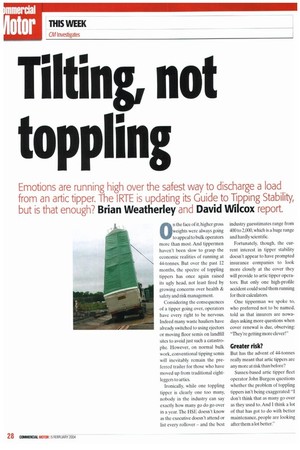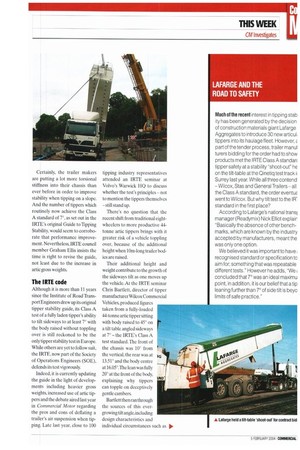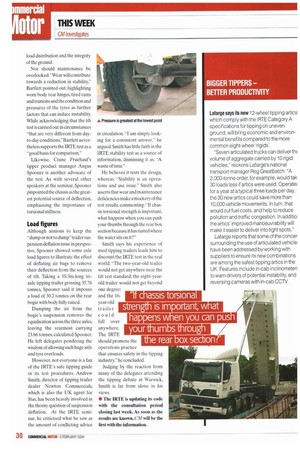Tilting, not toppling
Page 28

Page 29

Page 30

If you've noticed an error in this article please click here to report it so we can fix it.
Emotions are running high over the safest way to discharge a load from an artic tipper. The IRTE is updating its Guide to Tipping Stability, but is that enough? Brian Weatherley and David Wilcox report.
On the face of it, higher gross weights were always going to appeal to bulk operators more than most. And tippermen haven't been slow to grasp the economic realities of running at 44-tonnes. But over the past 12 months, the spectre of toppling tippers has once again raised its ugly head, not least fired by growing concerns over health & safety and risk management.
Considering the consequences of a tipper going over, operators have every right to be nervous. Indeed many waste hauliers have already switched to using ejectors or moving floor semis on landfill sites to avoid just such a catastrophe. However, on normal bulk work, conventional tipping semis will inevitably remain the preferred trailer for those who have moved up from traditional eightleggers to artics.
Ironically, while one toppling tipper is clearly one too many, nobody in the industry can say exactly how many go do go over in a year. The HSE doesn't know as the executive doesn't attend or list every rollover and the best industry guesstimates range from 400 to 2,000, which is a huge range and hardly scientific.
Fortunately, though. the current interest in tipper stability doesn't appear to have prompted insurance companies to look more closely at the cover they will provide to artic tipper operators. But only one high-profile accident could send them running for their calculators.
One tipperman we spoke to, who preferred not to be named, told us that insurers are nowadays asking more questions when cover renewal is due, observing: "They're getting more clever!"
Greater risk?
But has the advent of 44-tonnes really meant that artic tippers are any more at risk than before?
Sussex-based artic tipper fleet operator John Burgess questions whether the problem of toppling tippers isn't being exaggerated: "I don't think that as many go over as they used to. And I think a lot of that has got to do with better maintenance, people are looking after them a lot better. Certainly, the trailer makers are putting a lot more torsional stiffness into their chassis than ever before in order to improve stability when tipping on a slope. And the number of tippers which routinely now achieve the Class A standard of 7°, as set out in the IRTE's original Guide to Tipping Stability, would seem to corroborate that performance improvement. Nevertheless. IRTE council member Graham Ellis insists the time is right to revise the guide, not least due to the increase in artic gross weights.
The IRTE code
Although it is more than 11 years since the Institute of Road Transport Engineers drew up its original tipper stability guide, its Class A test of a fully laden tipper's ability to tilt sideways to at least 7° with the body raised without toppling over is still reckoned to be the only tipper stability test in Europe. While others are yet to follow suit, the IRTE, now part of the Society of Operations Engineers (SOE), defends its test vigorously.
Indeed, it is currently updating the guide in the light of developments including heavier gross weights, increased use of artic tippers and the debate aired last year in Commercial Motor regarding the pros and cons of deflating a trailer's air suspension when tipping. Late last year, close to 100 tipping industry representatives attended an IRTE seminar at Volvo's Warwick HQ to discuss whether the test's principles — not to mention the tippers themselves —still standup.
There's no question that the recent shift from traditional eightwheelers to more productive 44tonne artic tippers brings with it greater risk of a vehicle toppling over, because of the additional height when 10m-long trailer bodies are raised.
Their additional height and weight contribute to the growth of the sideways tilt as one moves up the vehicle. At the IRTE seminar Chris Bartlett, director of tipper manufacturer Wilcox Commercial Vehicles, produced Figures taken from a fully-loaded 44-tonne attic tipper sitting with body raised to 45° on a tilt table angled sideways at 7° — the IRTE's Class A test standard. The front of the chassis was 10" from the vertical, the rear was at 13.51° and the body centre at 16.05°.The lean was fully 20' at the front of the body, explaining why tippers can topple on deceptively gentle cambers.
Bartlett then ran through the sources of this evergrowing tilt angle.including design characteristics and individual circumstances such as load distribution and the integrity of the ground.
Nor should maintenance be overlooked."Wear will contribute towards a reduction in stability," Bartlett pointed out, highlighting worn body rear hinges, tired rams and trunions and the condition and pressures of the tyres as further factors that can induce instability White acknowledging that the tilt test is carried out in circumstances "that are very different from dayto-day conditions," Bartlett nevertheless supports the IRTE test as a "good basis for comparison.
Likewise, Crane Fruehauf's tipper product manager Angus Spooner is another advocate of the test. As with several other speakers at the seminar. Spooner pinpointed the chassis as the greatest potential source of deflection, emphasising the importance of torsional stiffness.
Load figures Although anxious to keep the -dump or not to dump" trailer suspension deflation issue in perspective, Spooner showed some axle load figures to illustrate the effect of deflating air bags to remove their deflection from the sources of tilt. Taking a 10.3m-long triaxle tipping trailer grossing 35.76 tonnes, Spooner said it imposes a load of 30.2 tonnes on the rear bogie with body fully raised.
Dumping the air from the bogie's suspension removes the equalisation across the three axles, leaving the rearmost carrying 23.66 tonnes, calculated Spooner. He left delegates pondering the wisdom of allowing such huge axle and tyre overloads.
However, not everyone is a fan of the IRTE's safe tipping guide or its test procedures. Andrew Smith, director of tipping trailer dealer Newton Commercials, which is also the UK agent for Stas, has been heavily involved in the thorny question of suspension deflation. At the IRTE seminar, he criticised what he saw as the amount of conflicting advice in circulation. "I am simply looking for a consistent answer,he argued. Smith has little faith in the IRTE stability test as a source of information, dismissing it as: "A waste of time."
He believes it tests the design. whereas: "Stability is an operations and use issue." Smith also asserts that wear and maintenance deficiencies make a mockery of the test results. commenting: "If chassis torsional strength is important, what happens when you can push your thumbs through the rear box section because it has rusted where the water sits on it?"
Smith says his experience of used tipping trailers leads him to discount the IRTE test in the real world. -The two-year-old trailer would not get anywhere near the tilt test standard; the eight-yearold trailer would not get beyond one degree; and the 16year-old trailer could fall over anywhere. The IRTE should promote the operations practice that ensures safety in the tipping industry," he concluded.
Judging by the reaction from many of the delegates attending the tipping debate at Warwick, Smith is far from alone in his views.
• The 1RTE is updating its code with the consultation period dosing last week. As soon as the results are known. CM will be the first with the information.


































































































































































































